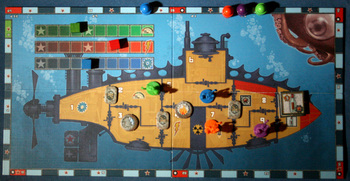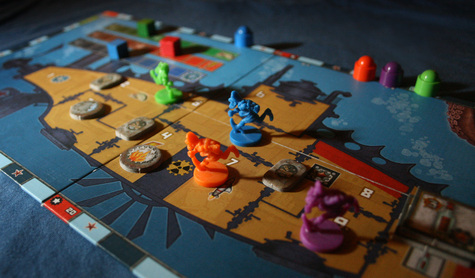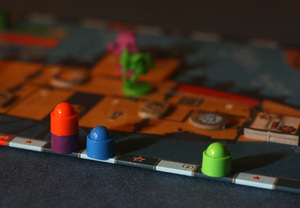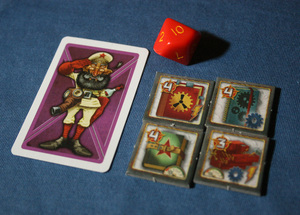Red November: Fun, but little more than surface deep

Mike Hulsebus | Contributor
Red November is a cooperative game in which players have to survive in their sinking submarine for 60 in-game minutes until rescue comes. Each player controls a gnome who will, over the course of the game, run into flaming rooms, fix engines, and make sure there’s enough oxygen to go around. There are a lot of co-op games to choose from, so let’s dive into how this game works and see if it sinks or swims (sorry, I couldn’t resist).

Mike Hulsebus | Contributor
By far and away, the coolest part about this game is how players take their turns. Let’s say that there is a room in the sub that is on fire and I want my gnome put it out. I have to figure out how much time this takes to do. Perhaps I have to move my gnome through two rooms and then make a check to put out that fire. The longer I spend making a check, the more likely I am to succeed. So if I were to spend 2 minutes getting to the room and then 7 minutes putting out the fire, I would get to roll a ten-sided die and then need to roll equal to or less than however much time I spent doing the action (7). Why not just spend 10 minutes every time for guaranteed success? That’s not always a good idea.

Each time that a time-tracking piece moves past a star, another event happens on the ship.
Mike Hulsebus | Contributor
Around the edge of the board, each player has a marker to record how much time that he has spent doing actions. To do my action, I had to move my marker a total of nine spaces forward. For every star space I pass on the time track, an event card gets turned over, usually detailing something bad that happens. So if I spent 10 minutes putting out that fire, two more fires may have started in other random rooms on the sub.
After my turn is over, whichever player is the farthest behind on the time track takes a turn. Someone who is a lot of spaces behind on the time track might have time to take a bunch of short, quick turns in a row while he catches up with the rest of the group. When doing an action, he could decide he would rather roll the die twice and have to get 3 or less once than to roll the die once and get 6 or less. How risky you want to be with your actions is really up to you. Not to get too math-y here (which I’m not even qualified to do) but I believe if you spend 3 seconds twice to try and do an action, you have a 51% percent chance of success as opposed to a 60% chance of success if you spent all six minutes on one attempt. The advantage, however, of doing the small action is that if you succeed, then you haven’t used the 3 seconds for the second roll and can spend it doing something else.
Yes, I made my way all the way up to Calculus II and I’m using my math skills to figure out dice probabilities. I am perfectly fine with that.
Despite how interesting these choices may sound (if you like probabilities), most of the time I’ve played, I still find myself choosing to take all them time necessary so that I cannot fail the roll. There are items on the board that give you a one-time +3 or +4 bonus on a target, so pretty frequently, someone among the crew has that +4 item and then can just spend 6 minutes on the action for guaranteed success. It’s completely against the spirit of the game, but it’s hard to pass up. You would think that this would result in guaranteed death, but it doesn’t.
A nice thing about the game is players don’t run into a situation where one experienced player gives all the orders while the other players just do what he says. The game is simple enough and random enough that everyone can run their own guy and it won’t mean guaranteed failure if someone doesn’t make the optimum move each turn.

The item tiles in Red November give bonuses to die rolls when trying to fix something on the ship.
Mike Hulsebus | Contributor
Another problem that some co-ops have is that you get to the end and you just say “Well. We won” or “Well. We lost” because it’s either anticlimactic or you just don’t get satisfaction from being victor over a piece of cardboard. In Red November, there is a great element at the end where players with an Aqualung item can choose to make an escape. If the gnomes left on the sub win, the deserter loses. If the sub sinks, the deserter wins. It ratchets up the “what’s going to happen?” tension right at the end.
Speaking of tension, I love games that allow you to push your luck and while Red November allows it, it certainly doesn’t encourage it: usually I suffer no ill effects from taking all the time I need to fix the sub. There are some tactical decisions in the game, yes, but for me it mostly feels like it can be played by going to the current largest threat, spending all the time necessary so that no die roll is involved, and then going onto the next dire circumstance that has appeared while you were doing the first thing. Red November takes about an hour to play and if I’m going to spend an hour playing a game, I don’t want to feel like I’m playing it on autopilot. That’s what Uno is for and Uno takes around 5 minutes to play, not 60.
There are people that love this game, but I’m just not one of them. Proponents of the game tell of the great game experiences they’ve had playing the game with 7 of their friends. That’s all well and good, but if you can say you had “a blast,” playing Red November, I think it’s because of the people that you played it with, not the game itself.
My root problem with the game is that it doesn’t do anything exceptionally better than other games on the market. If I want to play a co-op game, I will play Arkham Horror. If I don’t have time for Arkham Horror, I will play Forbidden Island. If I want to play a game where I’m on a ship that’s falling apart, I will play Space Alert or Galaxy Trucker.
There is no point to owning a game if you always pick up other, similar games first.. Red November is certainly fun and the turn order system is a cool novelty, but in my book, there are other games out there that are simply more fun which officially puts Red November on my trade list.
Mike Hulsebus appreciates you using your time actions to read his reviews. He hopes that while you have been reading this review, a fire hasn’t broken out in a random room in your house. If it has, call the fire department before emailing him at mikehulsebus@gmail.com

